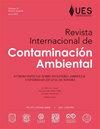碱土土壤质量指数(SQI)方法比较
IF 0.4
4区 环境科学与生态学
Q4 ENVIRONMENTAL SCIENCES
引用次数: 1
摘要
土壤退化和利用城市生物固体废物进行土壤恢复具有经济、社会、环境和健康影响。因此,全世界都对基于土壤物理、化学和生物指标建立土壤质量指数的方法的使用和比较感兴趣。考虑到瓜纳华托州墨西哥巴约地区60%以上的地区受到某种类型的土壤退化的影响,本研究比较了三种建立SQI的方法——添加指数、加权指数和统一加权指数,以评估添加生物固体作为土壤改良剂的短期效果——30天。将该方法应用于苏打农业土壤中碳(C)和氮(N)矿化动力学实验。铵指示剂(N-NH4+)被确定为与土壤质量最相关的指示剂。加性和统一加权指数区分了土壤质量在时间和处理方面的水平。开发的SQI可用于短期评估使用生物固体或类似有机产品进行改良添加处理的农业土壤质量。本文章由计算机程序翻译,如有差异,请以英文原文为准。
Comparison of methodolgies of soil quality indices (SQI) for sodic soil
Soil degradation and the use of urban biosolid wastes to soil restoration have an economic, social-environmental and health impact. Therefore, there is interest worldwide in the use and comparison of methodologies to establish soil quality indexes (SQIs) based on physical, chemical, and biological indicators of soils. Considering that more than 60% of the territory in the Bajío region of Mexico in the State of Guanajuato is affected by some type of soil degradation, three methodologies for the establishment of SQIs—additive, weighted and unified weighted indexes—were compared in this study to evaluate the short-term effects—30 days—of the addition of biosolids as soil improvers. The methodologies were applied in experiments on carbon (C) and nitrogen (N) mineralization dynamics in a sodic agricultural soil. The ammonium indicator (N-NH4+) was established as the one that is most related to the quality of the soil. The additive and unified weighted indexes differentiated the level of soil quality with respect to time and treatment. The developed SQIs can be used for short-term assessment of the quality of agricultural soils under amendment addition treatments with biosolids or similar organic products.
求助全文
通过发布文献求助,成功后即可免费获取论文全文。
去求助
来源期刊

Revista Internacional De Contaminacion Ambiental
ENVIRONMENTAL SCIENCES-
CiteScore
0.90
自引率
16.70%
发文量
59
期刊介绍:
En esta revista se aceptan para su publicación trabajos originales y de revisión sobre aspectos físicos y químicos de la contaminación, investigaciones sobre la distribución y los efectos biológicos y ecológicos de los contaminantes; así como sobre tecnología e implementación de nuevas técnicas para su medida y control; también son aceptados estudios sociológicos, económicos y legales acerca del tema. Se publicarán los escritos que mediante arbitraje de especialistas y a juicio del Consejo Editorial tengan el nivel y la calidad adecuados para ello y su contenido será responsabilidad única de los autores. La Revista Internacional de Contaminación Ambiental es de periodicidad trimestral y se publica los días 1 de febrero, mayo, agosto y noviembre.
 求助内容:
求助内容: 应助结果提醒方式:
应助结果提醒方式:


